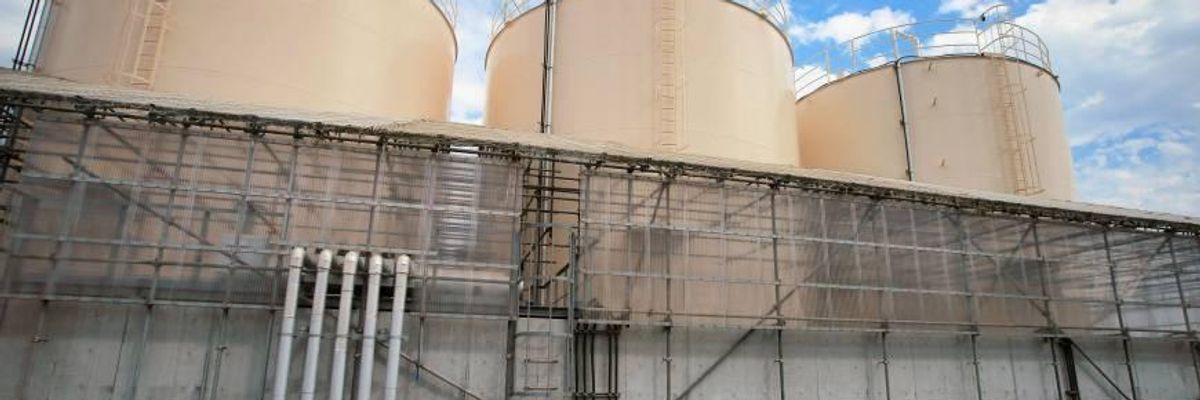

SUBSCRIBE TO OUR FREE NEWSLETTER
Daily news & progressive opinion—funded by the people, not the corporations—delivered straight to your inbox.
5
#000000
#FFFFFF
To donate by check, phone, or other method, see our More Ways to Give page.


Daily news & progressive opinion—funded by the people, not the corporations—delivered straight to your inbox.

Filtered groundwater stored in these tanks at the Fukushima No. 1 nuclear plant was discharged into the ocean Monday. | KYODO
Despite the objections of environmentalists and after overcoming local opposition from fishermen, the Tokyo Electric Power Co. (TEPCO) pumped more than 850 tons of groundwater from below the Fukushima nuclear power plant into the Pacific Ocean on Monday.
More than four years after a tsunami destroyed the plant and triggered a meltdown, the cleanup effort remains frought with numerous difficulties, including the nearly impossible task of dealing with the millions of gallons of contaminated and radioactive water--both treated and untreated--that have accumulated in thousands of tanks constructed in the shadow of the destroyed power station. On a daily basis, approximately 300 tons of groundwater are pumped to the surface to undergo treatment before being placed into storage.
According to Asahi Shimbun:
The discharge marks the first release under the utility's "subdrain plan," an additional measure conceived to help diminish the build-up of contaminated groundwater at the crippled facility.
TEPCO began discharging water after a third-party panel confirmed that the radioactive content was below the standard set by the utility.
The plan utilizes subdrains, which are essentially wells set up around the main buildings of the power plant to collect groundwater flowing into the complex. Once the groundwater has been pumped from those wells, it undergoes decontamination in a special facility for release into the ocean after being checked for radioactive content.
And Agence France-Presse adds:
The move is a milestone for the company, which said its Advanced Liquid Processing System, which removes highly radioactive substances like strontium and caesium, meant the ground water was now safe to release into the natural environment.
Fishermen had argued that the discharge even of the groundwater would heighten contamination concerns and hurt their already battered reputation.
They had fought to stop the water being released into the sea, even after it is filtered, but eventually bowed to pressure from TEPCO, which is struggling to find space to store the tainted supplies.
But it has yet to find a solution to deal with another highly radioactive 680,000 tonnes of water that was used to cool the reactors during the meltdown, which is still stored on site.
Fishermen are opposed to the fluid being released into the sea, even after it is filtered.
Dear Common Dreams reader, The U.S. is on a fast track to authoritarianism like nothing I've ever seen. Meanwhile, corporate news outlets are utterly capitulating to Trump, twisting their coverage to avoid drawing his ire while lining up to stuff cash in his pockets. That's why I believe that Common Dreams is doing the best and most consequential reporting that we've ever done. Our small but mighty team is a progressive reporting powerhouse, covering the news every day that the corporate media never will. Our mission has always been simple: To inform. To inspire. And to ignite change for the common good. Now here's the key piece that I want all our readers to understand: None of this would be possible without your financial support. That's not just some fundraising cliche. It's the absolute and literal truth. We don't accept corporate advertising and never will. We don't have a paywall because we don't think people should be blocked from critical news based on their ability to pay. Everything we do is funded by the donations of readers like you. Will you donate now to help power the nonprofit, independent reporting of Common Dreams? Thank you for being a vital member of our community. Together, we can keep independent journalism alive when it’s needed most. - Craig Brown, Co-founder |
Despite the objections of environmentalists and after overcoming local opposition from fishermen, the Tokyo Electric Power Co. (TEPCO) pumped more than 850 tons of groundwater from below the Fukushima nuclear power plant into the Pacific Ocean on Monday.
More than four years after a tsunami destroyed the plant and triggered a meltdown, the cleanup effort remains frought with numerous difficulties, including the nearly impossible task of dealing with the millions of gallons of contaminated and radioactive water--both treated and untreated--that have accumulated in thousands of tanks constructed in the shadow of the destroyed power station. On a daily basis, approximately 300 tons of groundwater are pumped to the surface to undergo treatment before being placed into storage.
According to Asahi Shimbun:
The discharge marks the first release under the utility's "subdrain plan," an additional measure conceived to help diminish the build-up of contaminated groundwater at the crippled facility.
TEPCO began discharging water after a third-party panel confirmed that the radioactive content was below the standard set by the utility.
The plan utilizes subdrains, which are essentially wells set up around the main buildings of the power plant to collect groundwater flowing into the complex. Once the groundwater has been pumped from those wells, it undergoes decontamination in a special facility for release into the ocean after being checked for radioactive content.
And Agence France-Presse adds:
The move is a milestone for the company, which said its Advanced Liquid Processing System, which removes highly radioactive substances like strontium and caesium, meant the ground water was now safe to release into the natural environment.
Fishermen had argued that the discharge even of the groundwater would heighten contamination concerns and hurt their already battered reputation.
They had fought to stop the water being released into the sea, even after it is filtered, but eventually bowed to pressure from TEPCO, which is struggling to find space to store the tainted supplies.
But it has yet to find a solution to deal with another highly radioactive 680,000 tonnes of water that was used to cool the reactors during the meltdown, which is still stored on site.
Fishermen are opposed to the fluid being released into the sea, even after it is filtered.
Despite the objections of environmentalists and after overcoming local opposition from fishermen, the Tokyo Electric Power Co. (TEPCO) pumped more than 850 tons of groundwater from below the Fukushima nuclear power plant into the Pacific Ocean on Monday.
More than four years after a tsunami destroyed the plant and triggered a meltdown, the cleanup effort remains frought with numerous difficulties, including the nearly impossible task of dealing with the millions of gallons of contaminated and radioactive water--both treated and untreated--that have accumulated in thousands of tanks constructed in the shadow of the destroyed power station. On a daily basis, approximately 300 tons of groundwater are pumped to the surface to undergo treatment before being placed into storage.
According to Asahi Shimbun:
The discharge marks the first release under the utility's "subdrain plan," an additional measure conceived to help diminish the build-up of contaminated groundwater at the crippled facility.
TEPCO began discharging water after a third-party panel confirmed that the radioactive content was below the standard set by the utility.
The plan utilizes subdrains, which are essentially wells set up around the main buildings of the power plant to collect groundwater flowing into the complex. Once the groundwater has been pumped from those wells, it undergoes decontamination in a special facility for release into the ocean after being checked for radioactive content.
And Agence France-Presse adds:
The move is a milestone for the company, which said its Advanced Liquid Processing System, which removes highly radioactive substances like strontium and caesium, meant the ground water was now safe to release into the natural environment.
Fishermen had argued that the discharge even of the groundwater would heighten contamination concerns and hurt their already battered reputation.
They had fought to stop the water being released into the sea, even after it is filtered, but eventually bowed to pressure from TEPCO, which is struggling to find space to store the tainted supplies.
But it has yet to find a solution to deal with another highly radioactive 680,000 tonnes of water that was used to cool the reactors during the meltdown, which is still stored on site.
Fishermen are opposed to the fluid being released into the sea, even after it is filtered.